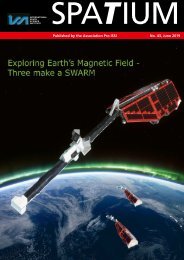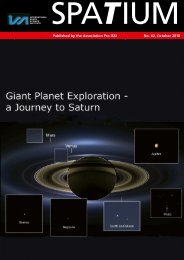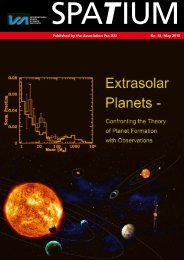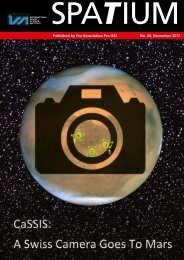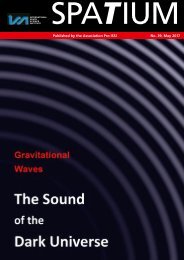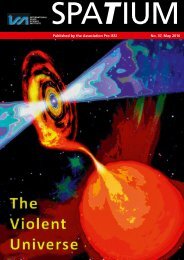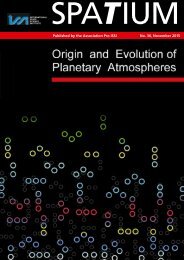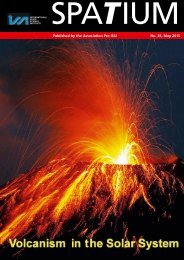The Moon That Thinks It's a Planet
by John Zarnecki (Spatium Volume 38)
by John Zarnecki (Spatium Volume 38)
You also want an ePaper? Increase the reach of your titles
YUMPU automatically turns print PDFs into web optimized ePapers that Google loves.
INTERNATIONAL<br />
SPACE<br />
SCIENCE<br />
INSTITUTE<br />
SPATIUM<br />
Published by the Association Pro ISSI No. 38, October 2016
Editorial<br />
14 January 2005 was a slow news<br />
day: nothing happened that justified<br />
an eye-catching headline.<br />
Hence, a calm day for the newspapers.<br />
Yet, a small note amongst<br />
all the daily trivialities meant relief<br />
from a seven year nightmare<br />
for numerous space scientists and<br />
engineers all over the world: Huygens<br />
had safely landed on Titan.<br />
Titan: the sorcerous name for an<br />
enigmatic moon in the outer solar<br />
system, more than one billion kilometres<br />
away. Huygens, a small<br />
space probe named in honour of<br />
Dutch scientist Christiaan Huygens,<br />
built by the European space<br />
community, had been seven years<br />
underway towards its remote destination<br />
Titan together with its<br />
US-American mate Cassini, commissioned<br />
to enter a literally unknown<br />
world.<br />
<strong>The</strong> challenges were numerous:<br />
Titan’s distance from Earth is so<br />
great that radio signals need one<br />
and a half hour to reach Earth and<br />
any corrective measure would need<br />
the same time again before becoming<br />
effective. Thus, there is no<br />
chance of intervening from Earth<br />
during the final critical moments<br />
when the probe approaches its destination<br />
with cosmic speed: a fully<br />
automatic mode of operation was<br />
required. Furthermore, is the surface<br />
of Titan liquid or solid? How<br />
cold is it there? No one knew.<br />
Huygens had to cope with all<br />
imaginable scenarios and in fact, it<br />
mastered its job excellently, imperturbably<br />
until the end of its short<br />
life on the surface, 72 minutes after<br />
touchdown. All these and many<br />
further challenges remain in the<br />
memories of the people who made<br />
the dream a reality.<br />
One of the Huygens mission’s leading<br />
scientists is Professor John Zarnecki,<br />
former Director of the<br />
Centre for Earth, <strong>Planet</strong>ary, Space<br />
& Astronomical Research at the<br />
Open University, Milton Keynes,<br />
England. He was the Principal Investigator<br />
of the Surface Science<br />
Package of Huygens, a suite of instruments<br />
that probed the moon’s<br />
atmosphere during descent and the<br />
surface properties after landing. It<br />
is with great pleasure that we present<br />
our readers today with his review<br />
of what an armada of scientists<br />
have found out since Huygens<br />
landed on Titan, eleven years ago.<br />
Even though Titan surprises us<br />
with its many similarities to our<br />
planet, its climate does not really<br />
qualify it as an alternative: the surface<br />
temperature is some 200 °C<br />
degrees lower than on Earth! Anyhow,<br />
we wish our readers a pleasing<br />
lecture about one of the fascinating<br />
worlds in which our solar<br />
system is so incredibly rich.<br />
Hansjörg Schlaepfer<br />
Cinuos-chel, October 2016<br />
Impressum<br />
ISSN 2297-5888 (Print)<br />
ISSN 2297-590X (Online)<br />
SPATIUM<br />
Published by the<br />
Association Pro ISSI<br />
Association Pro ISSI<br />
Hallerstrasse 6, CH-3012 Bern<br />
Phone +41 (0)31 631 48 96<br />
see<br />
www.issibern.ch/pro-issi.html<br />
for the whole Spatium series<br />
President<br />
Prof. Adrian Jäggi,<br />
University of Bern<br />
Layout and Publisher<br />
Dr. Hansjörg Schlaepfer<br />
CH-6614 Brissago<br />
Printing<br />
Stämpf li AG<br />
CH-3001 Bern<br />
SPATIUM 37 2
<strong>The</strong> <strong>Moon</strong> <strong>That</strong> <strong>Thinks</strong> It’s A <strong>Planet</strong>:<br />
Titan 1<br />
by Prof. John Zarnecki, Professor of Space Science, <strong>The</strong> Open University, Milton Keynes,<br />
England and International Space Science Institute, Bern<br />
Prologue<br />
This issue of Spatium picks up a<br />
subject that Spatium no. 15 addressed<br />
in November 2005 2 : Titan<br />
and the Huygens Mission. <strong>That</strong><br />
early report appeared a few months<br />
after the successful landing of the<br />
European Space Agency’s Huygens<br />
probe on Saturn’s largest moon Titan,<br />
a staggering 1,500 million kilometres<br />
away (Fig. 1). At that time,<br />
the science community was just<br />
starting to browse the wealth of<br />
data that Huygens had downloaded.<br />
In the meantime, the<br />
stream of science data did not<br />
cease, rather, NASA’s Cassini orbiter<br />
continued circling the Saturnian<br />
system providing a further<br />
cornucopia of data. <strong>The</strong> current issue<br />
of Spatium summarizes some<br />
major findings scientists all over<br />
the world have gained so far while<br />
the reader is kindly referred to<br />
Spatium 15 for technical information<br />
on the Cassini-Huygens twin<br />
spacecraft and its unique trajectory<br />
to the outer Solar System.<br />
Fig. 1: <strong>The</strong> yellowish moon Titan seen<br />
here by NASA’s Cassini orbiter behind<br />
Saturn’s A rings (in white) and F ring<br />
(in blue). Near the rings and appearing<br />
above Titan is Epimetheus, a small<br />
moon that orbits just outside the F ring.<br />
<strong>The</strong> dark space in the A ring is called<br />
the Encke Gap, the domain of the minute<br />
moon Pan. (Credit: ESA/NASA).<br />
1<br />
This text is based on a talk by Prof. John Zarnecki for the Pro ISSI audience on 28 October 2015.<br />
It was prepared by Dr. Hansjörg Schlaepfer and reviewed by Prof. Zarnecki.<br />
2<br />
See Spatium no. 15: Titan and the Huygens Mission by Nicolas G. M. Thomas, November 2005.<br />
SPATIUM 37 3
Introduction<br />
<strong>The</strong> Cassini-Huygens mission was<br />
conceived in the early 1990s. <strong>That</strong><br />
was at a time when our knowledge<br />
of Titan was scarce due to its enormous<br />
distance from Earth. Groundbased<br />
observations had yielded no<br />
more than some blurry pictures,<br />
and the images gained by Pioneer<br />
11 in 1979 and the two Voyager<br />
fly-bys in 1980 and 1981 respectively,<br />
could not improve the situation<br />
drastically. A thick opaque<br />
atmosphere obscures the moon<br />
(Fig. 2), and it was not known therefore,<br />
whether Huygens would land<br />
on a liquid or solid surface. This<br />
compelled the mission planners to<br />
take a broad variety of scenarios<br />
into account.<br />
In contrast, one thing was clear:<br />
the atmosphere is a complex chemical<br />
laboratory producing an astounding<br />
variety of organic molecules.<br />
Its major constituent is<br />
nitrogen, as is the case with the<br />
Earth’s atmosphere. In addition,<br />
one finds methane (CH 4 ), a gas<br />
that on our planet is produced by<br />
biological processes. Would this<br />
mean that the methane is a sign of<br />
present life on Titan? As methane<br />
is destroyed in time spans of 50<br />
million years by the solar ultraviolet<br />
radiation under the conditions<br />
prevailing on Titan that was<br />
an obvious, albeit far-reaching<br />
conclusion. <strong>The</strong> presence of methane<br />
makes an active source of fresh<br />
gas necessary that continuously replenishes<br />
the amount lost. Furthermore,<br />
under the temperature and<br />
pressure regime prevailing on Titan’s<br />
surface, methane is a liquid<br />
fuelling speculations about lakes<br />
and seas covering Titan, just like<br />
on Earth. In short, the methane<br />
mystery marked Titan as a prime<br />
target for a daring space mission<br />
amongst all the objects in the outer<br />
Solar System.<br />
Now, after the spectacular in-situ<br />
measurements made by the Huygens<br />
lander and the numerous<br />
fly-bys executed by Cassini in the<br />
meantime, our portrait of this<br />
enigmatic world has sharpened<br />
considerably and the intriguing<br />
similarities with our planet have<br />
become even more astonishing<br />
than before.<br />
Fig. 2: Size comparison of Earth<br />
with the <strong>Moon</strong> (left) and Titan (right).<br />
Titan’s diameter is 50 % larger than<br />
Earth’s <strong>Moon</strong>, and it is 80 % more massive.<br />
It is the second-largest moon in the<br />
Solar System, after Jupiter’s moon Ganymede,<br />
and is larger than the smallest<br />
planet, Mercury, although only 40 % as<br />
massive. (Credit: NASA)<br />
SPATIUM 37 4
Exciting Titan<br />
On Christmas Day 2004, Cassini’s<br />
on board computer generated a<br />
short but nonetheless important<br />
signal. It activated the Swiss made<br />
spring and eject device, which had<br />
attached the Huygens probe safely<br />
to the Cassini main craft for the<br />
past seven years (see box to the<br />
right). <strong>The</strong> mechanism now provided<br />
the probe the required spin<br />
and velocity vector towards its final<br />
destination, Titan, still 4 million<br />
km away (Fig. 3). Twenty days<br />
later, Huygens reached Titan’s<br />
outer atmosphere at a relative speed<br />
of 18,000 km/h, see Fig. 4 overleaf.<br />
<strong>The</strong> heat shield reduced the velocity<br />
to 1,400 km/h allowing the<br />
probe to eject the first parachutes<br />
to further reduce the speed down<br />
to 300 km/h. At 160 km above<br />
ground, the heat shield and the<br />
back cover were jettisoned allowing<br />
the probe’s instruments to fully<br />
take up their scientific tasks, which<br />
they executed with perfect precision.<br />
Titan’s Atmosphere<br />
Titan is unique in many respects.<br />
It is the only moon in the Solar System<br />
that features a fully developed<br />
atmosphere consisting of more<br />
than just trace gases. It was known<br />
to the mission planners that Titan<br />
has a dense, opaque, aerosol-rich<br />
atmosphere consisting mostly of<br />
nitrogen mixed with methane and<br />
traces of some ten additional molecules.<br />
Probing the composition of<br />
Swiss High Technology<br />
on Titan<br />
<strong>The</strong> then Contraves Space<br />
Company, Zurich, together<br />
with the Vevey based APCO<br />
were responsible for three main<br />
subsystems of the Cassini-Huygens<br />
twin spacecraft: once released,<br />
the spin and eject device<br />
provided the Huygens probe<br />
with the required thrust towards<br />
its final destination Titan. <strong>The</strong><br />
heat shield reduced the probe’s<br />
speed during atmospheric entry<br />
while the back cover shielded<br />
the suite of science instruments<br />
during the seven years of interplanetary<br />
cruising.<br />
this complex atmosphere at various<br />
altitudes and determining the temperature<br />
and pressure profile were<br />
Fig. 3 Probing the Saturnian system:<br />
NASA’s Cassini spacecraft is shown here<br />
in the centre a few moments after the<br />
release of ESA’s Huygens probe (to the<br />
lower left) heading toward its ultimate<br />
destination Titan in the lower background.<br />
(Credit: NASA)<br />
SPATIUM 37 5
Fig. 4: Huygens’ landing sequence:<br />
<strong>The</strong> probe dived at a speed of<br />
18,000 km/h into the atmosphere’s<br />
outer layers at an altitude of 1,270 km.<br />
<strong>The</strong> large heat shield served to reduce<br />
the entry velocity down to 1,400 km/h<br />
at about 150 km altitude. At this<br />
moment, Huygens’ onboard computer<br />
ordered the ejection of the pilot parachute,<br />
which in turn opened the first<br />
main parachute, as well as the ejection<br />
of the back cover. At a velocity of<br />
95 m/s, the front shield is jettisoned and<br />
replaced by a small stabilizer parachute<br />
that allows the probe to drift slowly<br />
through the atmosphere. Upon surface<br />
impact, the probe sat calmly on the<br />
moon’s surface at an ambient temperature<br />
of –180 °C. For about 70 minutes,<br />
it remained active before falling into an<br />
eternal silence. <strong>The</strong> radio signals from<br />
Titan need some 1.5 hours to reach our<br />
planet. This precludes controlling the<br />
descent sequence from Earth and makes<br />
a fully automatic mode of operation a<br />
must. (Credit: after an ESA image)<br />
therefore amongst Huygens’ chief<br />
objectives.<br />
Atmospheric Temperature<br />
and Pressure Profiles<br />
<strong>The</strong> main instrument for probing<br />
the temperature and pressure during<br />
descent was the Huygens<br />
Atmo spheric Structure Instrument<br />
(HASI). In contrast to expectations,<br />
the atmosphere turned out<br />
to be highly stratified (Fig. 5).<br />
Above 500 km, the average temperature<br />
was in the order of –100 °C<br />
with strong variations of some<br />
20 °C due to inversion layers. Below,<br />
the temperature increased<br />
rapidly, reaching a maximum of<br />
–87 °C at 250 km. Further down,<br />
the temperature decreased steadily<br />
again throughout the stratosphere,<br />
reaching a minimum of –203 °C at<br />
the boundary between the stratosphere<br />
and the troposphere. <strong>The</strong>n,<br />
the temperature increased again as<br />
the probe neared the surface, rising<br />
to a chilly –180 °C at the landing<br />
site. Due to the extreme thickness<br />
of the atmosphere, the<br />
atmospheric pressure at the landing<br />
site was about 1.5 times that at<br />
the surface of the much more massive<br />
Earth.<br />
Atmospheric Dynamics<br />
<strong>The</strong> term dynamics refers to the<br />
movement of the atmospheric particles<br />
at different altitudes. During<br />
descent, the Huygens probe was<br />
attached to parachutes and their relative<br />
movement projected down to<br />
SPATIUM 37 6
chemistry instruments aboard.<br />
One of the most important was the<br />
Gas Chromatograph and Mass Spectrometer<br />
(GCMS) for determining<br />
the chemical composition of Titan’s<br />
atmosphere during descent.<br />
As only very little was known<br />
when the mission was planned, the<br />
GCMS had to fulfil extreme requirements.<br />
It had to combine an<br />
excellent sensitivity (10 parts in 1<br />
billion molecules) with a very wide<br />
range of particles (molecular mass<br />
range from 2 to 146 amu, where<br />
one atomic mass unit amu is equal<br />
to 1 ⁄12th of the mass of a 12 C atom).<br />
<strong>The</strong> GCMS performed excellently<br />
delivering detailed mass spectra<br />
during descent (Fig. 6 on the next<br />
page).<br />
Fig. 5: Titan’s upper atmosphere consists of a surprising number of different<br />
layers of haze, as shown in this ultraviolet image of Titan’s night side limb gathered<br />
by Cassini’s cameras. <strong>The</strong>se layers extend several hundred kilometres above the surface,<br />
much higher than the Earth’s atmosphere. (Credit: NASA)<br />
the ground allowed for an estimation<br />
of the atmospheric dynamics<br />
at various heights. In fact, the probe<br />
experienced a rough ride: over the<br />
duration of the entire descent, the<br />
probe glided eastward for a distance<br />
of 166 km. <strong>The</strong> winds were generally<br />
prograde, that is in the same<br />
direction as the moon’s rotation.<br />
<strong>The</strong> wind speed peaked at roughly<br />
120 m/s at an altitude of about<br />
120 km. This is much faster than<br />
the rotation speed on the moon’s<br />
equator. This strange effect is called<br />
super-rotation, known to exist on<br />
Venus as well. Such super-rotating<br />
winds are supposed to be driven by<br />
interactions of the atmosphere with<br />
the solar wind.<br />
Chemical Composition of<br />
the Atmosphere<br />
Of course, the outstanding complexity<br />
of Titan’s atmosphere was<br />
one of the key drivers for launching<br />
a mission to Titan and an exceptional<br />
challenge for the scientists<br />
and engineers who built the<br />
instruments. In fact, Huygens had<br />
an entire suite of atmospheric<br />
Formation and Evolution of<br />
the Atmosphere 3<br />
<strong>Planet</strong>ary atmospheres are supposed<br />
to have formed in either one<br />
or a combination of two principal<br />
ways. During Solar System formation,<br />
a body’s gravity attracted<br />
parts of the surrounding gas and<br />
dust constituting the protosolar<br />
nebula. <strong>The</strong> gaseous components<br />
of this matter then built the atmosphere,<br />
while the solids contributed<br />
to the body’s mass. Later, planetesimals<br />
– the small evolving bodies<br />
circling the early Sun – were captured<br />
and their material integrated<br />
into the emerging planetary body.<br />
<strong>The</strong> impact of gas-rich planetesimals<br />
is supposed to have contributed<br />
further to building up the<br />
atmosphere.<br />
3<br />
See also Spatium no. 36: Formation and Evolution of <strong>Planet</strong>ary Atmospheres by Helmut Lammer, November 2015.<br />
SPATIUM 37 7
A variation on this theme is accretion<br />
from a characteristic sub-nebula<br />
in the region surrounding an<br />
emerging giant planet. <strong>The</strong> composition<br />
of such an atmosphere<br />
seems to reflect a special blend of<br />
solar nebula accretion and degassing<br />
from planetesimals: Jupiter for<br />
instance has an endowment of<br />
heavy noble gases and other heavy<br />
elements relative to hydrogen that<br />
is greater than existed in the solar<br />
nebula at those times. In contrast,<br />
the rarity of noble gases in the<br />
Earth’s atmosphere is interpreted<br />
as being a consequence of planetesimal<br />
influx, and the near absence<br />
of noble gases on Titan provides<br />
further support for this<br />
hypothesis.<br />
Atmospheric Nitrogen<br />
<strong>The</strong> most abundant constituent is<br />
nitrogen, and its origin remains<br />
one of Titan’s great mysteries. In<br />
the stratosphere, some 300 km<br />
above ground, nitrogen reaches<br />
concentrations of 98.4 %. As the<br />
Earth’s atmosphere also contains<br />
some 80 % nitrogen, one could infer<br />
that the atmospheres of planets<br />
and moons would contain nitro-<br />
Fig. 6: <strong>The</strong> chemical composition of<br />
Titan’s atmosphere. <strong>The</strong> two panels<br />
present the overall mass spectrum gathered<br />
at an altitude of around 120 km and<br />
on the surface. A first glance provides<br />
an impression of the incredible complexity<br />
of the chemical composition of<br />
Titan’s atmosphere testifying that a<br />
wealth of chemical reactions is taking<br />
place there. Further, the similarity of<br />
the two diagrams suggests that the surface<br />
is soaked with products from the<br />
chemistry taking place in the upper atmosphere<br />
and raining down onto the<br />
surface. As expected, the main components<br />
are N 2 (nitrogen) and CH 4 (methane).<br />
Further notable constituents are<br />
the noble gas Argon 40 Ar, a series of increasingly<br />
complex organic molecules<br />
beginning with ethane (C 2 H 6 ), carbon<br />
dioxide CO 2 , cyanide (C 2 N 2 ), benzene<br />
(C 6 H 6 ) up to 140 atomic mass units.<br />
(Credit: ESA)<br />
SPATIUM 37 8
gen in major amounts. Yet, this is<br />
not the case; rather, Earth and Titan<br />
are notable exceptions. This led<br />
scientists to speculate that the actual<br />
atmosphere of Titan might resemble<br />
that of our planet in its early<br />
pre-biotic time that is before living<br />
organisms began enriching it<br />
with oxygen via photosynthesis.<br />
In order to allow study of the possible<br />
origins of nitrogen, the<br />
GCMS tracked the ratio of a variety<br />
of isotopes and trace species<br />
during descent. More specifically,<br />
it focussed on heavy noble gases<br />
such as argon 36 Ar, 38 Ar, krypton<br />
(Kr), and xenon (Xe). <strong>The</strong>se gases<br />
had been identified earlier in meteorites,<br />
in the atmospheres of<br />
Earth, Mars, Venus (to some extent),<br />
and Jupiter. <strong>The</strong>y were possibly<br />
present throughout the solar<br />
nebula before the planets and<br />
moons formed, and should therefore<br />
have been incorporated into<br />
both Saturn and Titan during the<br />
early stages of planetary system formation.<br />
Condensation of gases on<br />
the young Titan would have resulted<br />
in the capture of 36 Ar, as<br />
well as nitrogen, in proportions<br />
present in the protoplanetary disk<br />
at those times, for which the composition<br />
of today’s Sun is a good<br />
proxy. However, the depleted nitrogen<br />
ratio detected by Huygens<br />
implies that it was captured as ammonia<br />
(NH 3 ) or in other nitrogenbearing<br />
compounds. Subsequent<br />
photolysis in a hot proto-atmo s-<br />
phere generated and heated up by<br />
the accreting Titan or possibly<br />
impact-driven chemistry of NH 3<br />
is supposed to have led to the nitrogen<br />
atmosphere we have on Titan<br />
today.<br />
Atmospheric Methane<br />
An even greater mystery is the<br />
presence of methane in Titan’s atmosphere<br />
because the Sun’s ultraviolet<br />
radiation destroys methane,<br />
which would disappear completely<br />
after some 50 million years. <strong>The</strong>refore,<br />
there must be a mechanism at<br />
work that continuously replenishes<br />
the losses incurred.<br />
In order to shed light on this secret,<br />
the GCMS tracked the levels<br />
of methane in the atmosphere. Initially,<br />
in the highest atmospheric<br />
layers, it found only low concentrations<br />
of methane. <strong>The</strong>n, at some<br />
40 km, the concentration started<br />
increasing gradually until at approximately<br />
7 km the concentration<br />
reached saturation level. Further<br />
down, methane concentrations<br />
remained relatively constant until<br />
the probe touched down on the<br />
surface. Immediately after landing,<br />
the methane concentration increased<br />
by about 40 %, while the<br />
nitrogen count rate remained constant.<br />
This suggests the presence of<br />
liquid methane on the surface sputtered<br />
by the incoming probe or by<br />
the spacecraft heating the surface<br />
material.<br />
While on Earth, methane is normally<br />
a product of biochemical<br />
processes, measurements of the<br />
carbon isotopes contained in Titan’s<br />
methane ruled out the possibility<br />
of production by microorganisms.<br />
This leads to the<br />
hypothesis that Titan’s methane<br />
stems from underground (or surface)<br />
reservoirs. It is thought that<br />
Titan had accreted methane during<br />
its formation, and large quantities<br />
of liquid methane are assumed<br />
to be trapped in ice beneath<br />
the surface, possibly reaching the<br />
surface through some form of<br />
cryo-volcanism. This activity<br />
could indeed replace the methane<br />
lost by photochemistry in the upper<br />
atmosphere.<br />
Beyond its very presence, methane<br />
stands out by the role it plays on<br />
Titan, which strongly resembles<br />
the role of water on Earth. On our<br />
planet, water evaporates from the<br />
oceans to the atmosphere, from<br />
where it rains down to the surface<br />
again. River systems collect the<br />
water and bring it back to the<br />
oceans thereby closing the water<br />
cycle. On Titan, the temperature<br />
is far too low for liquid water, but<br />
it is in the right range for methane<br />
to be liquid. In fact, there exists a<br />
complex methane cycle embracing<br />
the surface lakes, the clouds and the<br />
methane rains. A further analogy<br />
deserves attention: on Earth, the<br />
pressure and temperature values<br />
are close to the triple point of water,<br />
where water can exist either as<br />
solid, liquid or gas. On Titan, the<br />
pressure and temperature values<br />
are very close to the triple point of<br />
methane, allowing it similarly to<br />
exist in the solid, liquid or the gaseous<br />
state. This makes liquid and<br />
solid methane possible at the<br />
moon’s surface.<br />
Noble Gases in the Atmopshere<br />
Noble gases along with their isotopes<br />
play a key role when it comes<br />
to hypothesising on the evolution<br />
of Titan’s atmosphere. Out of the<br />
numerous components found, 40 Ar-<br />
SPATIUM 37 9
gon stands out, a noble gas that<br />
does not exist naturally, but is always<br />
a by-product of radioactive<br />
decay of potassium in rocky material.<br />
<strong>The</strong> presence of 40 Ar is a very<br />
strong support in favour of a rocky<br />
core at the centre of Titan as we<br />
will see below.<br />
Atmospheric Aerosols<br />
Aerosols are tiny solid or liquid<br />
particles suspended in a gaseous environment.<br />
To address the role of<br />
aerosols in Titan’s atmosphere, the<br />
Huygens probe carried the Aerosol<br />
Collector and Pyrolyser (ACP)<br />
experiment aboard. This instrument<br />
collected aerosol particles and<br />
heated them in a special oven to<br />
vaporise all the volatile components<br />
in order to analyse their<br />
chemical composition.<br />
<strong>The</strong> ACP acquired two atmospheric<br />
samples during the descent,<br />
one at an altitude of 130 km and<br />
the other at 25 km. <strong>The</strong> main substances<br />
found in the aerosols were<br />
ammonia (NH 3 ) and hydrogen<br />
cyanide (HCN) confirming that<br />
carbon and nitrogen are major<br />
constituents of the aerosols. <strong>The</strong><br />
two samples did not show substantial<br />
differences, which indicates<br />
that the aerosols’ composition was<br />
probably the same at both altitudes.<br />
This finding supports the idea that<br />
the aerosols have a common source<br />
in the upper atmosphere, where,<br />
the ultraviolet part of the sunlight<br />
splits the atmospheric gases such as<br />
methane allowing the emergence<br />
of the aerosols (Fig. 7).<br />
Fig. 7: <strong>The</strong> emergence of aerosols in the atmosphere of Titan. When sunlight<br />
(or highly energetic particles from Saturn’s magnetosphere) hits the upper layers<br />
of Titan’s atmosphere, the nitrogen and methane molecules are broken up. This<br />
results in the formation of massive positive ions and electrons, which trigger a chain<br />
of chemical re actions, producing a variety of hydrocarbons. <strong>The</strong>se reactions eventually<br />
lead to the production of carbon-based aero sols, large aggregates of atoms<br />
and molecules that Huygens found in the lower layers of the atmosphere. Large carbon-based<br />
molecules form from aggregations of smaller hydrocarbons high up in<br />
the atmosphere. Upon reaching a certain size, they drift down much like snowflakes<br />
and eventually give rise to aerosols. (Credit: ESA)<br />
SPATIUM 37 10
In parallel to the chemical analyses<br />
of the aerosols, the Descent Imager/Spectral<br />
Radiometer (DISR)<br />
characterised their optical properties.<br />
<strong>The</strong> results show that they<br />
strongly resemble tholins 4 , molecules<br />
which can be produced in the<br />
laboratory by sending electrical<br />
discharges into mixtures of nitrogen<br />
and methane. This provides an<br />
indication regarding their production<br />
mechanisms (Fig. 7).<br />
Titan’s Surface<br />
Huygens’ descent lasted about 150<br />
minutes. <strong>The</strong>n, the probe made a<br />
softish landing on Titan’s surface<br />
and shortly after sent the first picture<br />
to a nervous audience staring<br />
at their TV screens on Earth. It was<br />
a long awaited, spectacular moment:<br />
Huygens had survived the<br />
touchdown and started working on<br />
the surface. <strong>The</strong> first image shows<br />
a dry river or lakebed with pebbles<br />
and sand-like material (Fig. 8). <strong>The</strong><br />
probe recorded an ambient temperature<br />
of about -180°C. Despite<br />
the frosty temperature, the probe’s<br />
thermal control system protected<br />
the sensitive onboard electronics<br />
and instruments, and during the<br />
following 72 minutes, a huge<br />
amount of unique data was collected<br />
and subsequently downloaded<br />
via the Cassini orbiter.<br />
Dry river beds and lakes<br />
Immediately before touch down,<br />
Huygens made the first physical<br />
contact with the surface by means<br />
of a small penetrometer consisting<br />
of a rod or stick protruding through<br />
the probe’s hull. Its purpose was to<br />
measure the forces acting on the<br />
Fig. 8: A close-up view of Huygens’<br />
landing site resembling a dried-up<br />
river or lakebed. Rounded cobbles, 10<br />
to 15 cm in diameter and probably made<br />
of hydrocarbons and water ice, rest on<br />
a darker granular surface. <strong>The</strong>se pebbles<br />
are rounded which is indicative of an<br />
erosion process by liquids, most probably<br />
liquid methane. (Credit: ESA/<br />
NASA)<br />
probe during the very moment of<br />
landing. Fig. 9 shows the penetrator<br />
signal produced during landing.<br />
<strong>The</strong> peak force registered at<br />
8 ms is thought to be caused by hitting<br />
a smaller pebble, as the big<br />
hard pebbles that can be seen in<br />
Fig. 8 would have broken the instrument.<br />
<strong>The</strong> subsequent part of<br />
the signal representing medium<br />
strength forces is interpreted as<br />
pushing down to the underlying<br />
softer, granular material, probably<br />
Titan’s equivalent of sand. Notwithstanding<br />
the fact that the<br />
penetrometer was quite a simple<br />
instrument, its signal provided a<br />
great deal of information on the<br />
character of Titan’s surface at the<br />
landing site.<br />
This information is complemented<br />
by the imagery gained by the Cassini<br />
orbiter during its more than<br />
150 fly-bys made since its entry<br />
into the Saturnian system. Surprisingly,<br />
the dense haze, that charac-<br />
Fig. 9: <strong>The</strong> Huygens penetrometer<br />
signal during landing. <strong>The</strong> horizontal<br />
axis is calibrated in units of milliseconds,<br />
while the vertical axis shows<br />
the force of Titan’s surface acting on the<br />
penetrator probe. (Credit: ESA)<br />
4<br />
<strong>The</strong> term “tholin” was coined by the American astronomer, Carl Sagan (1934–1996) to describe substances he obtained<br />
in experiments simulating the gas mixtures in Titan’s atmosphere. Tholins are not one specific compound but rather are<br />
descriptive of a spectrum of molecules that give a reddish, organic surface covering on certain planetary surfaces.<br />
SPATIUM 37 11
terises Titan’s atmosphere, offers<br />
some narrow spectral windows<br />
where Cassini’s cameras could peer<br />
right down to the surface. In addition,<br />
Cassini’s radar was able to image<br />
the surface undisturbed by the<br />
haze. <strong>The</strong> results of this survey<br />
were nothing less than a sensation<br />
(Fig. 10): it turned out that Titan<br />
and Earth are the only places in the<br />
Solar System where stable liquids<br />
exist on the surface. While on<br />
Earth, the lakes are made of water,<br />
on Titan they probably consist of<br />
liquid methane. <strong>The</strong> hypothesis of<br />
liquid surfaces was corroborated by<br />
an infrared image gained by chance<br />
(see Fig. 11).<br />
Fig. 11: A telling image of Titan’s<br />
surface: here, Cassini’s infrared camera<br />
looks back after a fly-by. A bright<br />
red spot appears on the surface almost<br />
blinding the instrument. It is the Sun’s<br />
specular reflection on Cracken Mare,<br />
one of the many methane lakes of Titan.<br />
<strong>The</strong> picture is a stunning proof of<br />
the existence of liquid surfaces on Titan.<br />
(Credit: NASA)<br />
Fig. 10: This false colour radar image from the Cassini orbiter shows a surface<br />
strip of Titan’s surface. <strong>The</strong> yellow-hued terrain appears to be peppered with<br />
blue-tinted lakes and seas of liquid methane. (Credit: NASA)<br />
Dunes<br />
Besides seas and lakes, there are additional<br />
features on Titan that resemble<br />
areas on Earth: the dunes.<br />
<strong>The</strong>y cover various parts of Titan’s<br />
surface and are probably composed<br />
of sand-sized hydrocarbon and/or<br />
nitrile grains mixed with water ice.<br />
In contrast, however, to dunes on<br />
Earth, the particles constituting<br />
the dunes on Titan are supposed to<br />
have rained down from the atmosphere.<br />
Later, they may have been<br />
eroded by liquid methane runoff<br />
and moved by eolian processes.<br />
Sizes and patterns of the dunes vary<br />
as a function of altitude and latitude.<br />
<strong>The</strong> dunes in areas that are<br />
more elevated or in higher latitudes<br />
tend to be thinner and more widely<br />
separated, with gaps that have a<br />
thinner covering of sand. Dunes in<br />
lower altitude and latitude regions<br />
are wider, with thicker blankets of<br />
sand between them. Comparing<br />
these features with dunes on Earth<br />
shows that the Kalahari dunes in<br />
South Africa and Namibia, located<br />
in regions with limited sediments<br />
available resemble the first type of<br />
dunes while on the other hand,<br />
Earth’s Oman dunes in Yemen and<br />
Saudi Arabia, where there is abundant<br />
sediment available, resemble<br />
the second type more.<br />
This altitude effect suggests that<br />
the material building the dunes is<br />
found mostly in the lowlands of<br />
Titan. Saturn’s elliptical orbit<br />
around the Sun along with Titan<br />
being tidally locked to Saturn<br />
make the summers on the moon’s<br />
southern hemisphere shorter and<br />
warmer than in the northern hemi-<br />
SPATIUM 37 12
sphere. This leaves the soil in the<br />
south possibly dryer due to increased<br />
evaporation during the<br />
hotter summer time. In contrast,<br />
in the northern hemisphere, the<br />
soil hypothetically contains more<br />
moisture, making it more difficult<br />
to build dunes and to move their<br />
particles because they are stickier<br />
and heavier.<br />
Titan’s Interior<br />
<strong>The</strong> data provided by Huygens and<br />
Cassini allows speculation about<br />
the moon’s interior. <strong>The</strong> currently<br />
preferred physical models suggest<br />
a core of solid silicate rock as is the<br />
case with most bodies of the Solar<br />
System. <strong>The</strong>n, above, follows a<br />
layer of water ice under high pressure,<br />
and possibly a large subsurface<br />
ocean covered by the moon’s<br />
icy surface.<br />
A Subsurface Ocean?<br />
<strong>The</strong> argument for a water-based<br />
ocean below the surface is based on<br />
extremely precise observations of<br />
Cassini’s trajectories during the<br />
fly-bys. <strong>The</strong> orbital parameters of<br />
these trajectories allow for the estimation<br />
of the pull of gravity and<br />
its fluctuations and since gravity is<br />
an indication of the distribution of<br />
matter within the moon, these data<br />
allow for the building of models of<br />
Titan’s interior. From these observations,<br />
one can deduce the existence<br />
of a global ocean of water.<br />
Such an adventurous hypothesis<br />
needs corroboration by independent<br />
findings. Radar images of Titan’s<br />
surface show that some of its<br />
features are in the wrong place at<br />
the wrong time! Obviously, the<br />
rotation of Titan’s surface is not as<br />
expected. At a much finer level,<br />
one can make similar observations<br />
on Earth and Mars, where the atmosphere<br />
and the solid body continuously<br />
transfer momentum between<br />
each other. With the<br />
impressive mass contained in Titan’s<br />
thick atmosphere one might<br />
presume a similar process, but it is<br />
much bigger than expected. <strong>The</strong><br />
only way to explain this observation<br />
is to say that the surface is decoupled<br />
from the bulk of the core<br />
by floating on an ocean of liquid<br />
water in between.<br />
Further results point in the same<br />
direction: Huygens had instruments<br />
aboard that allow the detection<br />
of lightning in the moon’s atmosphere.<br />
On Earth, thousands of<br />
lightning flashes take place every<br />
minute, and each bolt generates a<br />
radio crackle. <strong>The</strong>y propagate in<br />
the form of extremely low frequency<br />
(ELF) pulses around the<br />
globe in the cavity formed by<br />
Earth’s surface and the ionosphere,<br />
a region of electrically charged particles<br />
in Earth’s upper atmosphere.<br />
Although Huygens did not detect<br />
any lightning or thunderstorms, it<br />
registered an ELF signal at around<br />
36 Hz. In order to explain this<br />
unique signal, scientists have proposed<br />
that Titan’s atmosphere<br />
might act like a giant electrical circuit<br />
where electrical currents are<br />
generated in the ionosphere when<br />
it interacts with Saturn’s magnetosphere.<br />
While Huygens found electrically<br />
conductive ionospheric layers<br />
at about 60 km above the<br />
surface, the cavity’s lower boundary<br />
reflecting the ELF signals could<br />
be an electrically conductive ocean<br />
of water and ammonia below a<br />
non-conducting icy crust.<br />
A Rocky Core?<br />
<strong>The</strong> indication for a rocky core<br />
comes from the Argon isotope 40 Ar<br />
detected by the Huygens Gas<br />
Chromatograph Mass Spectrometer.<br />
This noble gas does not exist<br />
naturally, rather, it is the exclusive<br />
decay product of potassium 40 K<br />
contained in radioactive rock. This<br />
noble gas offers, therefore, a unique<br />
window to the interior of Titan as<br />
the only possible source of 40 Ar is<br />
the rock existing deep in Titan’s<br />
interior.<br />
Cryo-volcanism?<br />
<strong>The</strong> term cryo-volcano refers to a<br />
geologic feature working at very<br />
low temperatures, where material<br />
from the underground protrudes<br />
up to the surface. On Titan, there<br />
are possibly about half a dozen of<br />
such cryo-volcanoes (see Fig. 12<br />
overleaf). <strong>The</strong> presence of 40 Ar at<br />
the levels seen by Huygens is a<br />
strong indication of geological<br />
activities on Titan consistent with<br />
the assumed periodic replenishment<br />
of atmospheric methane. In<br />
fact, cryo-volcanism provides one<br />
possible process for release of methane<br />
and 40 Ar from the interior out<br />
into the atmosphere.<br />
Besides the circular features interpreted<br />
as cryo-volcanoes, there are<br />
also a few patterns interpreted as<br />
SPATIUM 37 13
impact craters (Fig. 13). On Titan,<br />
we see at most ten such features.<br />
While most surfaces in the Solar<br />
System are peppered with impact<br />
craters, Titan’s surface is very<br />
sparsely cratered. <strong>The</strong>re are probably<br />
two reasons for this. One is<br />
the thick atmosphere, which acts<br />
as a filter, causing the smaller impacting<br />
bodies to burn up before<br />
reaching the surface. <strong>The</strong> other<br />
factor is the dynamic nature of the<br />
surface. Weathering by wind and<br />
liquids obliterate the impact craters<br />
over long time spans. This is another<br />
indication, that the surface is<br />
active.<br />
Fig. 13: Sinlap is a relatively fresh<br />
impact crater with a diameter of about<br />
80 km. (Credit: NASA)<br />
Fig. 12: A surface feature that is interpreted<br />
as a cryo-volcano, a type of<br />
volcanism operating at very low temperatures.<br />
Lava welling up to form the<br />
volcanic mound is a semifluid of methane,<br />
ammonia, and water ice combined<br />
with other ices and hydrocarbons. <strong>The</strong><br />
circular feature is roughly 30 kilometres<br />
in diameter. (Credit: NASA)<br />
SPATIUM 37 14
Life on Titan?<br />
<strong>The</strong> similarities of Earth’s and Titan’s<br />
atmospheres were one basic<br />
motivation for ESA and NASA to<br />
send a mission to Titan. Upcoming<br />
speculations about the existence<br />
of some unknown form of<br />
life provided an additional thrust<br />
to embark on such an outstandingly<br />
daring mission. Now, after<br />
its completion, the similarities have<br />
become even more compelling,<br />
but also the differences between<br />
the two.<br />
<strong>The</strong> similarities refer to the organic<br />
chemistry taking place in Titan’s<br />
atmosphere that resembles the<br />
chemical processes on our early<br />
planet that possibly paved the way<br />
for the emergence of life. In addition,<br />
Titan has a greenhouse effect<br />
like Earth contributing to stabilising<br />
the global climate. Geological<br />
similarities are striking as well:<br />
liquid bodies, river networks,<br />
dunes, mountains and hills, and<br />
possibly even some sort of tectonic<br />
activity may be at work. <strong>The</strong> chief<br />
difference is temperature: while on<br />
Earth, the mean surface temperature<br />
is around 17 °C, on Titan it is<br />
a mere −180 °C. <strong>The</strong>refore, water<br />
at the surface exists in the solid<br />
state exclusively; yet methane may<br />
assume the role of water on Titan<br />
as a solvent for living systems. In<br />
addition, water-based living systems<br />
might evolve in Titan’s warm<br />
subsurface ocean. <strong>The</strong> Cassini-<br />
Huygens mission did not provide<br />
evidence for any form of life on Titan;<br />
in fact, it was not equipped to<br />
do so.<br />
Outlook<br />
<strong>The</strong> Cassini-Huygens mission is a<br />
seminal success not only from a scientific<br />
point of view but also with<br />
regard to the effective transatlantic<br />
cooperation between the two<br />
space agencies ESA and NASA.<br />
Yet, unsurprisingly, many questions<br />
remain open. This gives ample<br />
motivation to plan a further<br />
mission to that miraculous, distant<br />
world which in many respects is so<br />
astonishingly similar to ours. Such<br />
a new mission could exploit the detailed<br />
information delivered by<br />
Cassini-Huygens and the special<br />
conditions prevailing on Titan: its<br />
thick atmosphere and low gravity<br />
(about 1 ⁄7 of Earth’s) may be an<br />
ideal place for an approach based<br />
on aerial vehicles: from a balloon<br />
or a Montgolfier, cameras could<br />
observe the moon’s surface conveniently<br />
at close quarters. From<br />
what we know about the winds, it<br />
would take something like two<br />
weeks to execute an entire circuit<br />
at the equator to find the most interesting<br />
places where a lander<br />
could then address specific issues.<br />
An alternative could be a probe<br />
floating on one of Titan’s many<br />
lakes. In any case, Titan remains<br />
an outstandingly compelling destination<br />
for future science<br />
missions.<br />
Fig. 14: Constituents of a hypothetical follow-on mission to explore Titan<br />
include an aerial platform, an orbiter and a lander.<br />
SPATIUM 37 15
SPATIUM<br />
<strong>The</strong> Author<br />
John Zarnecki grew up in London,<br />
England. In his early years, space<br />
and space exploration attract ed his<br />
attention and it is no wonder that<br />
the youngster was amongst the public<br />
when Yuri Gagarin, the first<br />
human astronaut visited London in<br />
1961. John started his studies at<br />
Queens’ College, Cambridge,<br />
where he graduated with a physics<br />
degree before obtaining a doctorate<br />
at the Mullard Space Science<br />
Laboratory (University College<br />
London) in Surrey.<br />
Prepared with a sound scientific<br />
education, John Zarnecki started<br />
his professional career at British<br />
Aerospace working in a team developing<br />
the Hubble Space Telescope’s<br />
Faint Object Camera. <strong>The</strong>n,<br />
in 1981, he moved to the University<br />
of Kent in Canterbury to become<br />
the project manager for the<br />
Dust Impact Detection System on<br />
board ESA’s Giotto probe that visited<br />
Halley’s Comet. Yet the most<br />
exciting programme was still<br />
ahead: the Huygens probe scheduled<br />
to land on Saturn’s moon<br />
Titan, some 1.5 billion kilometres<br />
away. John Zarnecki was appointed<br />
Principal Investigator for Huygens’<br />
Surface Science Package in<br />
1990. <strong>The</strong> instrument collected<br />
over three and a half hours of data,<br />
which, thanks to its efficient encoding,<br />
could be stored on board<br />
the lander before being relayed by<br />
the Cassini orbiter down to Earth.<br />
In 2000, John Zarnecki, along<br />
with the other members of the Surface<br />
Science Package team, moved<br />
to the Open University in Milton<br />
Keynes, in central England, where<br />
he became Director of the Centre<br />
for Earth, <strong>Planet</strong>ary, Space & Astronomical<br />
Research, some years<br />
later. In 2013, Professor Zarnecki<br />
was invited to take up a Directorship<br />
at the International Space<br />
Science Institute in Berne,<br />
Switzerland.<br />
Prof. Zarnecki has given long and<br />
distinguished service to the global<br />
space community, working in numerous<br />
international teams and<br />
committees such as for instance for<br />
ESA’s Senior Review Committee,<br />
charged with selecting the scientific<br />
themes that would form the basis<br />
for ESA’s L2 and L3 missions in<br />
2028 and 2034, respectively.<br />
An outstanding, charismatic personality,<br />
Prof. John Zarnecki has<br />
been granted numerous honours of<br />
which the Gold Medal of the Royal<br />
Astronomical Society in 2014<br />
stands out.




